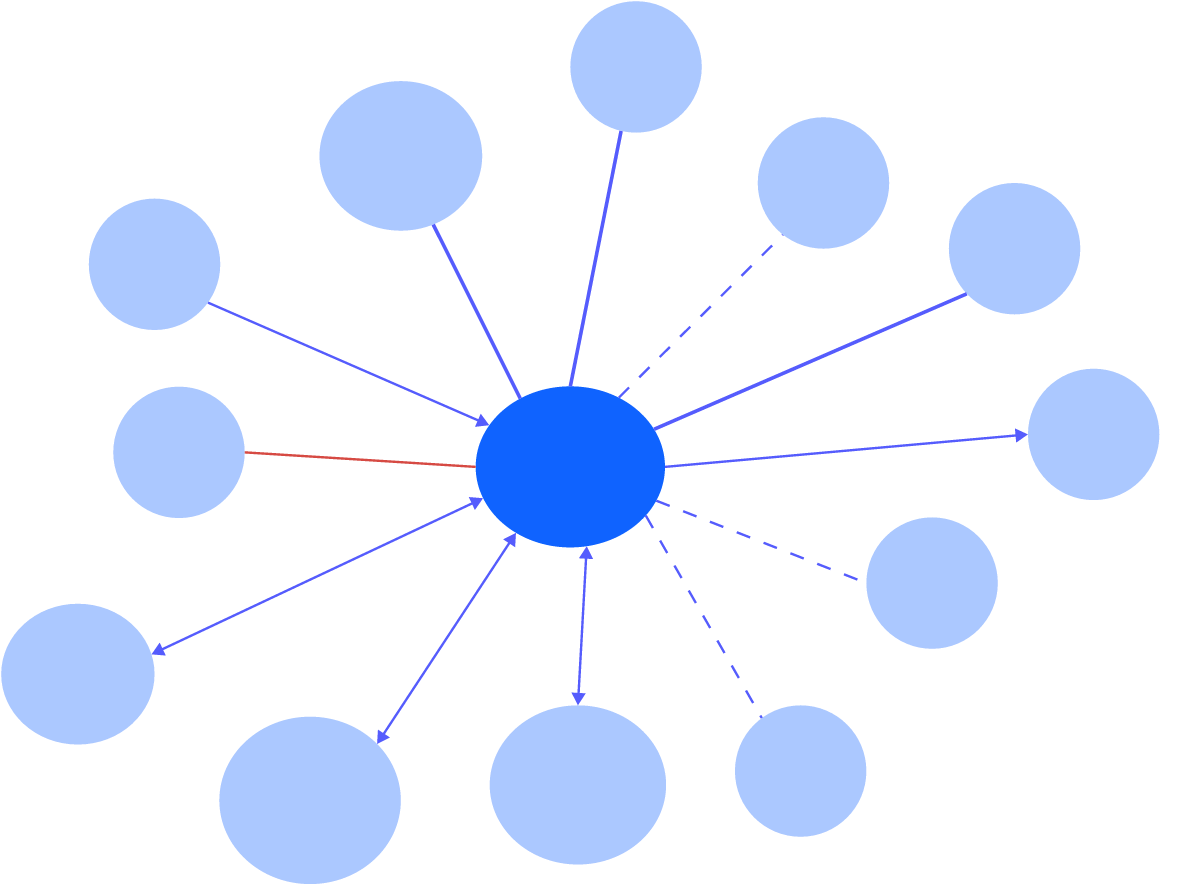Every great idea cannot turn into a successful product. You cannot just simply start developing the product once you think the idea is worth it. It always requires proper brainstorming sessions to research and discuss the true potential of the idea before jumping into the development phase. All these aspects from idea researching and roadmapping to product development and release can be done effectively with a well-structured product management process.
When a business has set up the right product management process in place, it leads to a streamlined flow of a project from screening ideas to getting feedback from customers about the MVP release. So, what is the product management process and what are the steps to execute it are the main discussion points of this article.
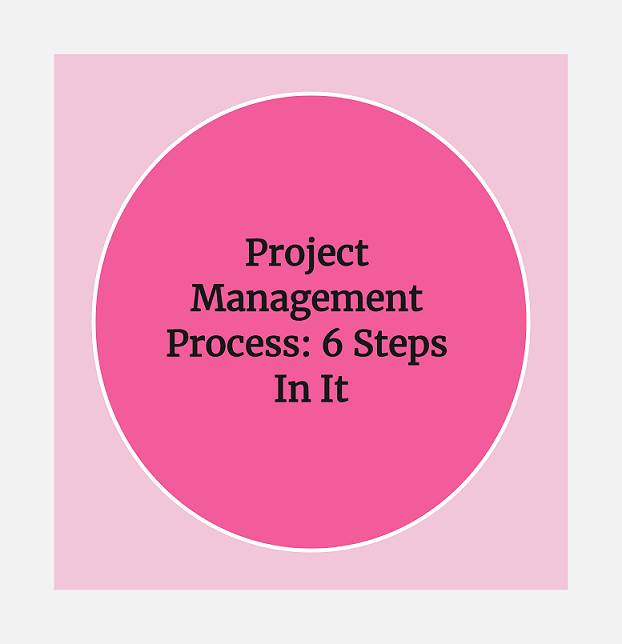
Part 1. What Is the Product Management Process?
In simple words, the product management process is a comprehensive process of managing the entire product life cycle from the initial idea to the market release. What are the customer needs, how the product can serve the needs, how to create the product, what features should be prioritized, and similar other aspects are all addressed effectively within the product management process?
Overall, the production process is a lengthy process that involves participation from different departments and stakeholders, but it does streamline the whole product lifecycle. Below are the seven stages of the product management process:
- Market and user research
- Brainstorming ideas
- Turning ideas into actions
- Roadmapping
- Prioritizing
- Development
- MVP release & customer feedback
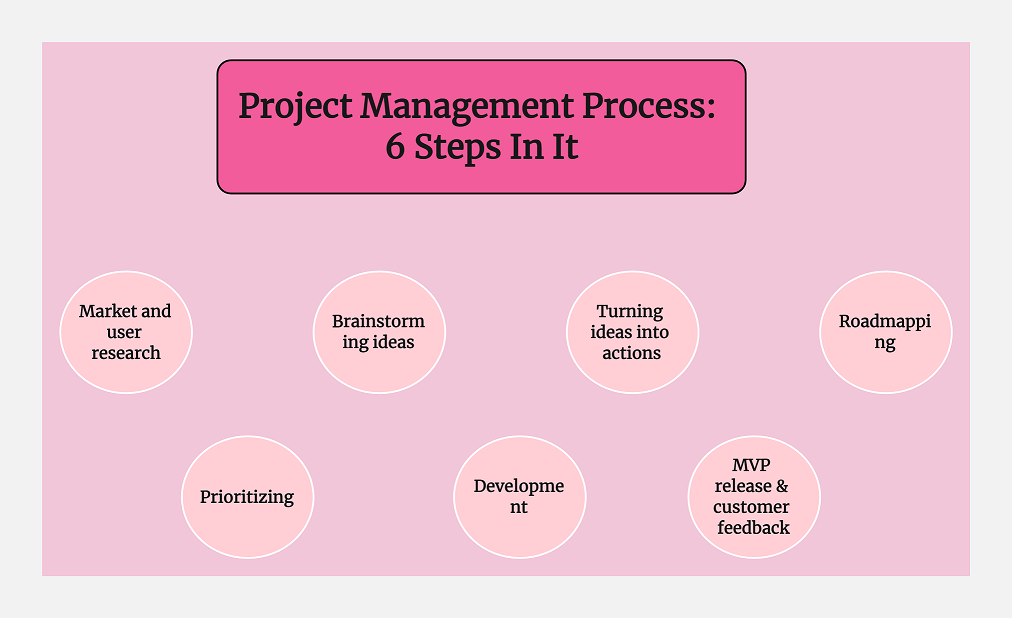
There are no standardized stages/steps to follow in a product management process. The process can vary from business to business and can change as the business gets more experienced with product management practices.
Part 2. Why Is the Product Management Process Important?
The product management process is crucial to delivering great products to customers and keeping the development, sales, marketing, and other teams focused. Some of the main reasons why the product management process is important are as follows:
- It helps craft customer requirements in detail and evaluates the product idea thoroughly.
- It helps to develop an effective roadmap for streamlined development.
- It addresses the ever-changing customer needs effectively with the feedback system in place.
- It is a central hub of information for different departments to have real-time insights about the product's current phase, capabilities, etc.
- It increases collaboration among different departments, thereby leading to a better mutual understanding of the product.
- It encourages the "go-to-market" strategy for product success, which is much needed in this competitive era.
Overall, the product management process helps businesses turn great ideas into successful products and keep improving with changing customer needs.
Part 3. 6 Steps of the Product Management Process
Now that we know what the product management process is all about and its need in the current business world, it's time to focus on what are the core steps of the product management process. However, one thing you should know is that the product management process requires the use of the right tool to make it easy to keep the process central and let members from different departments collaborate effectively. That's where Boardmix comes into action.
Boardmix is an all-in-one online collaborative whiteboard that integrates various tools, such as Mind Map, Flowchart, Frames, Timeline, Brainwriting, Reverse Brainstorming, Daily Work Report, and plenty of other tools, to make product management a streamlined and hassle-free experience. Moreover, the built-in templates and real-time collaboration support make it easy to present and brainstorm ideas, create roadmaps, set timelines, and do all product management-related activities from one central online dashboard.

Let's now discuss how Boardmix can help to execute the 6 must-do steps of the product management process:
Step 1. Market and User Research
Once you have a great idea, the first and crucial step is to do thorough market and user research. You have to identify that is the market potential behind that idea, who are the competitors, and what user needs the idea can fulfill.
To conduct market research, you can conduct quantitative research (surveys, interviews, and questionnaires) and qualitative research (observations, focus groups, and in-depth market view). Once you have a dataset to present to the rest of the team, you can use the Boardmix Mind Map tool to present the information in a visual way. Follow the below steps to create a Boardmix Mind Map:
- Sign up or log in to Boardmix.
- From the main home screen, click "Mind Map" and then click "Use".
- Customize the Mind Map with your dataset.
- Once done, you can share it with others for real-time collaboration by clicking the "Share" button from the top right corner.
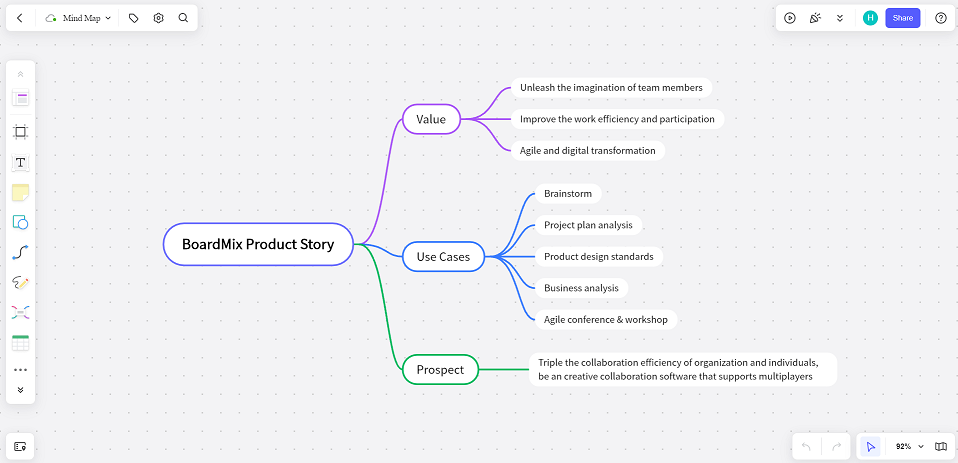
Once you have done thorough research on the idea from both market and user perspectives, you are all set to head for the next step.
Step 2. Idea Management with Product Discovery
With the proper market and user research, you are now in the position to find solutions to the user problems with your idea, commonly known as "Product Discovery". In this step, you and the rest of the team closely evaluate what are the user needs and problems and then validate your idea for solutions.
Boardmix can help in the product discovery step with its template-based solutions. For instance, you can use the "Reverse Brainstorming" tool to stimulate new thoughts and find solutions. Follow the below steps to use Boardmix to do reverse brainstorming:
- From the main home screen of Boardmix, click "Reverse Brainstorming".
- Customize the content and also share it with others to collaborate in real-time.
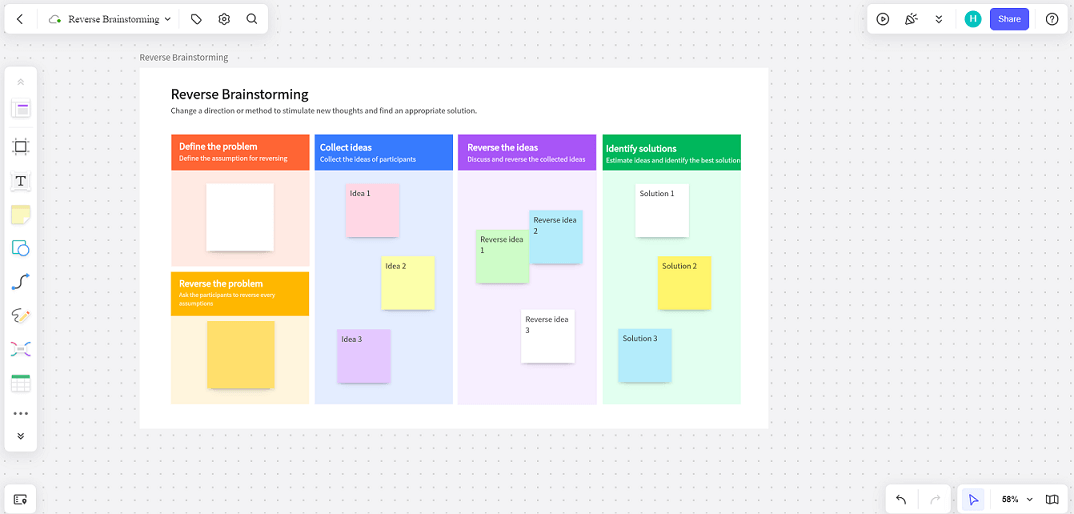
Once you have identified authentic solutions to user needs/problems, you can now head for creating technical specifications.
Step 3. Setting Technical Specifications or List of Requirements
Both product discovery and market research should now be translated into technical specifications or a list of requirements. The task here is to create user stories of the requirements so that the development team can have a better understanding of what features they have to develop to build a minimal viable product (MVP) version.
Since multiple individuals can be involved in setting technical specifications, Boardmix offers multiple tools to assist in this process. One such tool is Brainwriting which lets multiple participants write down their ideas and refine others' ideas as well. Follow the below steps to use the Boardmix Brainwriting tool:
- From the main home screen of Boardmix, click "Brainwriting".
- Share the worksheets with the participants by clicking the "Share" button from the top right corner.
- Customize the content of the template collaboratively.
- Once you have finalized the user stories, you can export them in different formats. So, click the drop-down menu next to the "Brainwriting" text and then click "Export file".
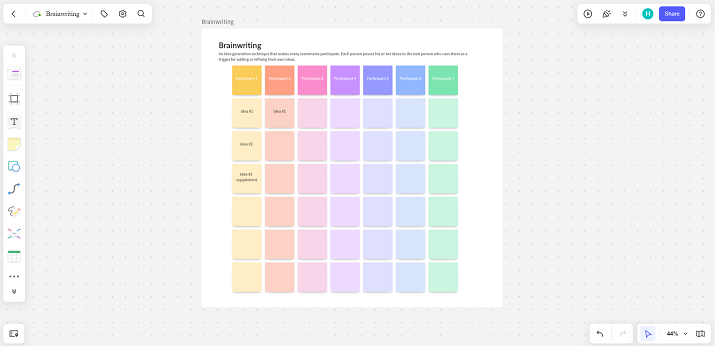
Once you have technical specifications or a list of requirements in hand, you are all set to develop the roadmap for the project.
Step 4. Roadmapping
The development team now has to go through the user stories and finalize which ones they are going to work on first. So, the team develops a roadmap that is based on keeping the product vision in mind.
Boardmix assists here with the dedicated Roadmap tool that lets you create a roadmap using the built-in template easily. Follow the below steps to use the Boardmix Roadmap tool:
- From the main home screen of Boardmix, click "Roadmap".
- Customize the content and also share it with others to collaborate in real-time.
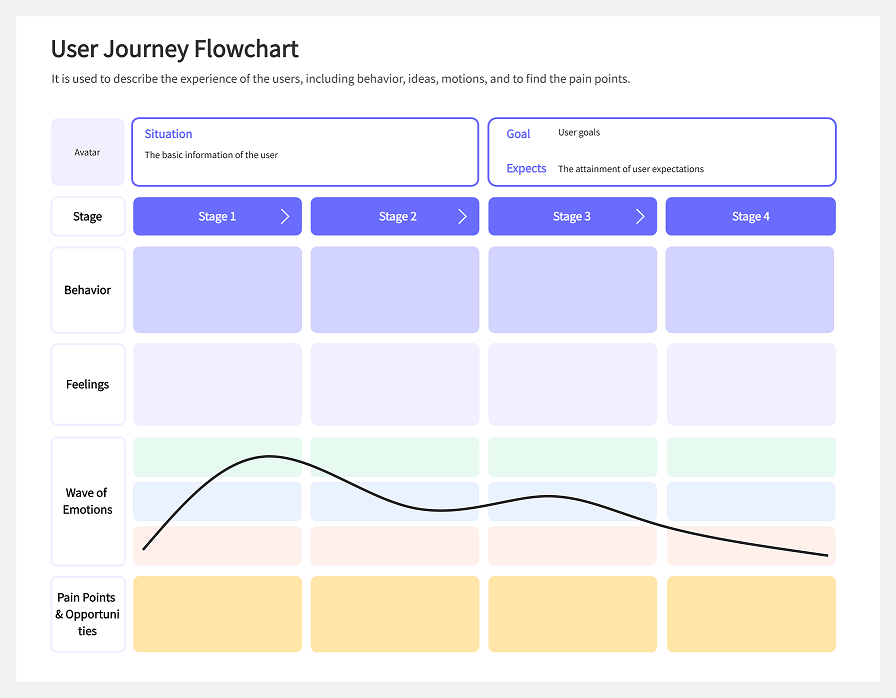
That is the last stage in the planning phase and now the action shifts to product development.
Step 5. Product Development
After all the brainstorming sessions, you now have all the requirements, user stories, and details to turn the idea into a product. Product development can go on for weeks/months depending on the nature of the idea and involves different activities, such as creating a project timeline, conducting daily meetings, setting weekly plans, etc.
Boardmix offers a bunch of tools to assist in product development, such as Flowcharts, Weekly Plans, Daily Work Reports, Timelines, Daily Scrum Meetings, etc. So, the development team can use Boardmix to have better management of the product development phase.

Step 6. Product Launch and Feedback Collection
Once the Minimum Viable Product (MVP) is developed, the team goes for the launch. During this step, sales, marketing, and other teams also join the development team to launch the product rightly. After the successful launch of the product, the next thing is to keep on collecting feedback from users and keep improving the product.
Boardmix helps teams here with different tools that can make it easy for cross-departmental teams to collaborate on finalizing the product launch and discussing the feedback from users. Mind Map, Brainwriting, Reverse Brainstorming, and similar other tools offered by Boardmix can serve the needs of teams during this phase.

Part 3. Best Practices to Streamline Product Management
A streamlined product management process not just makes it easy to turn ideas into products, but also reduces the chances of struggling with uncertainties around product development and launch. Below are some of the best practices to streamline product management:
- Reduce time starting new projects with standardized steps and the use of templates.
- Ensure real-time and seamless collaboration.
- Automate assigning work, i.e., the tasks are assigned to the right team members by default.
- Better manage priorities, especially related to the minimum viable product (MVP).
- Reduce cross-team redundancy for the same data sets.
- Provide real-time visibility of all the works.
- Document standard product management steps your organization takes to help newbies.
Overall, streamlining product management with the right set of processes can take time, but once they are established, it makes the workflow efficient, employees productive, and stress-level manageable.
Conclusion
The product management process is not a set of stages/steps you have to follow blindly. Every stage/step has a target to achieve that relies on how you implement it. However, it becomes a lot easier to set up an effective product management cycle with the right tool. As discussed above, Boardmix presents as the ideal companion for businesses in the product management process. From Mind Map, Flowchart, Roadmap, Timeline, Venn Diagram, and other tools powered with real-time collaboration, Boardmix makes every stage of the product management process streamlined and more rewarding.







